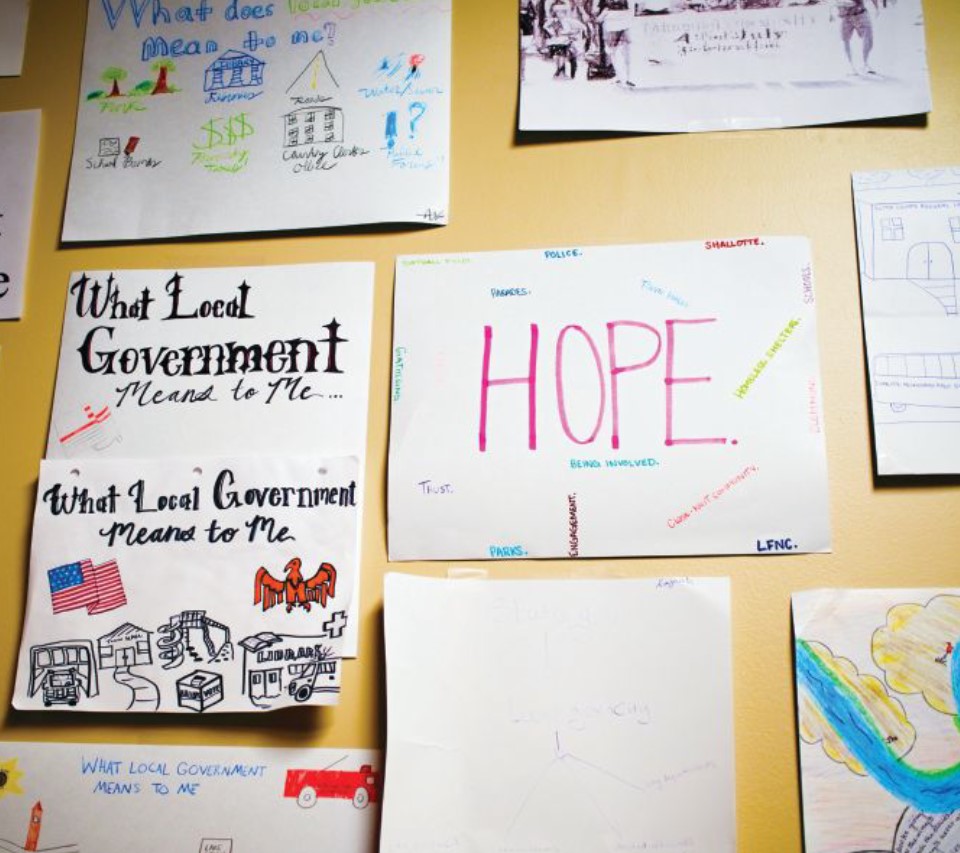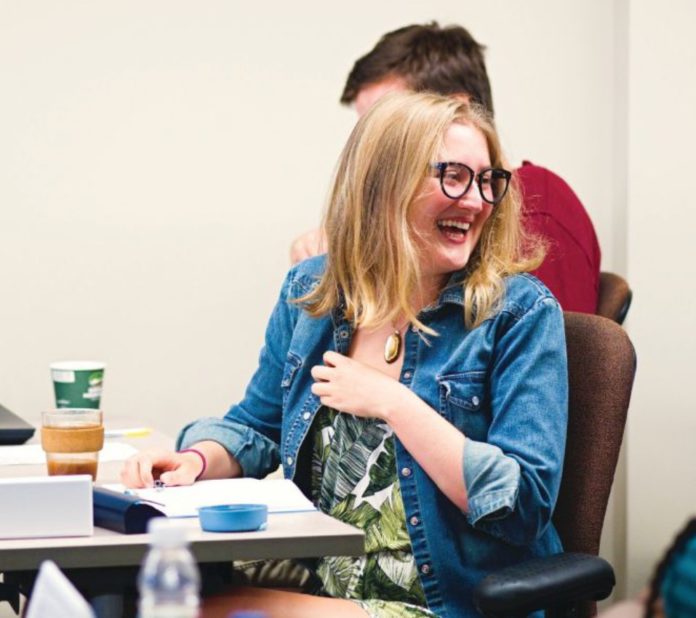Fresh out of college, filled with passions and finding a path, the fellows of the Lead for North Carolina program are not unlike many other recent graduates.
Unique, however, may be the level of impact they are making. Micro-transit projects, community development initiatives, wide-ranging social research, land use plans, communications strategies—these achievements cover only some of the successes of the 2019 cohort, a group with largely no previous experience.
That freshness may actually be their most valuable attribute.
“The curiosity and inquisitiveness that comes with being new and being young is helpful—it can breed good ideas,” said Sarah Arney, now working in Kinston after recently graduating from UNC-Chapel Hill. “The positivity and, maybe, naiveté—feeling like this is something I can change, or this is something I can improve. How could this be better? How could this be different? Those are good questions to ask.”
When evaluating the effect of youth on local governments, Lead for North Carolina provides a pretty compelling test case. The fellowship’s first installment took 16 bright and budding graduates and placed them into cities and counties around the state, 12 of which were economically distressed, Tier 1 communities.
Supported by the League and the UNC School of Government, the program lowers the barriers to entry on both ends of the equation. The fellows are eased into their burgeoning career and receive ongoing education, and the communities themselves receive an influx of talent that they may otherwise be unable to afford. On average, the communities save more than $25,000 compared to if they had hired a full-time equivalent.
This backing targets two key challenges for local governments: budget restraints and limited staff capacity. By eliminating those factors, the fellowship provides a cleaner look into the affect that new ideas, new perspective, and new talent can have on the local government setting.
Start with the towns. In North Topsail Beach, the community suffered through Hurricane Florence in 2018 with a limited staff, and as a result, public outreach during the storm was poor. The citizens made their complaints known. Enter India Mackinson, a graduate of UNCChapel Hill whose course of study—a BA in environmental studies and a minor in media and journalism— uniquely aligned with the town’s previous shortcoming. Relying on this background, Mackinson developed an emergency communications strategy that was implemented almost immediately upon her arrival in fall 2019.

“When we saw Hurricane Dorian coming our way, we knew it was a huge priority for staff to make sure that citizens knew what was going on,” said Mackinson. “We got a lot of positive feedback. It was a huge improvement in communication.”
In Elizabeth City, Shom Tiwari improved hurricane resiliency by evaluating the town’s sewer system and proposing targeted upgrades. In Elkin, Danielle Key serves as the festival director for NC Trail Days and heads “Explore Elkin”—a tremendously successful community outreach program that plans and promotes local events. And in Kinston, Arney has launched “Kinston 101,” an educational program that aims to develop involved citizens into local ambassadors.
There has also been a noticeable rise in civic pride, seen most clearly in two locations. Berekia Divanga made that impact in Washington after only a few months, when she nominated the city to be the NC Rural Center’s Small Town of the Year, detailing, as she said, “all the ways Washington is great—and I wrote it from experience.” It won.
“That was big time,” said Washington councilman and NCLM President William Pitt. “Municipal governments need young bright people. “They bring things to city government that people like myself do not know. Young people are the key.”
Wilson experienced a similar boost of civic pride through not only the great contributions of fellow Dante Pittman—which includes direct work on a micro-transit pilot project— but almost more so through just his presence. Wilson is Pittman’s hometown.
“You can tell among community leaders and folks who are interested in what’s going on in Wilson, when they see someone come back who cares and who has a sense of service, it inspires them in a way that not many things do in local government,” Pittman said. “It’s a privilege for me to know that something as simple as coming home to work on behalf of my hometown has inspired so many.”
To each of them, pursuing this program fell in line with a pervasive professional goal, which was to exercise their talents in the fulfillment of a sense of service. In some cases, it has affirmed the fellow’s initial longterm plans, whether that be nonprofit work, government involvement, or community activism. And in other cases, such as Saoirse Scott’s, the experience brought murky career paths into focus.
A few months in a local government setting highlighted just exactly what community impact can look like.
“Before, I thought that I would want to work for a large campaign or do something on a very large scale,” said Scott, whose fellowship is in Edenton. “Now, the direction I’m going to take will be on a much smaller level. I hadn’t been as open to moving to a small town. Now, that’s what I want.”
It’s a common epiphany. For recent graduates, where to direct one’s talent is a pivotal question, and more and more often, the only fulfilling answer will be one that also takes into account the desire for public service. The proverbial question of “What do you want to do with your life?” is now accompanied by the follow up of, “And why do you want to do it?”
To NCLM Director of Business and Membership Development Services Jennifer Cohen, municipal government is the perfect, if not surprising, home for those attributes.
“There’s a synergy between what youth wants and what municipal government as a career path can deliver,” said Cohen. “You really can be hands on, you really can innovate, you really can make exponential difference. The skills that youth have right now are the skills that local governments need.
“Plus, it’s not charity—it’s a stable career.”
Walker Harrison discovered this synergy first hand. Graduating from the University of North Carolina at Chapel Hill in 2019 with a BA in Geography and concentrations in Environmental Systems and Geospatial Analysis, Harrison had a passion for how people interacted with space and the places they live in.
He also wanted an active and difference-making career that both occasionally moved him away from the computer screen and directly addressed those elements of placemaking that were so attractive to him.
“What to do? That was a question I was really working through,” Harrison said. He considered city planning, but wasn’t sure there was a job out there that could exactly meet his demands. Then he went to the local government offices of Spindale.
“This has been the best education on what planners actually do,” Harrison said. “Each day, I know I’m working on projects that I know help the community. And the really interesting thing, we’re serving the citizens, even if they don’t recognize that we are.”
Can this symbiosis exist outside of a financially supported program? By placing young talent into municipal government settings at all, the fellowship makes notable progress in moving that enterprise forward, but there are limits, particularly on time. The fellowship ends. And when it does, the burdens on local governments rush back in.
The goal, then, should be to leave a legacy—leave the town in a better place than when you found it. It’s a mission each fellow seemed acutely aware of.
“I have made incremental progress,” said Liam Brailey, who is working in Anson County. “I don’t think I’ve made long-lasting progress yet, but I’m very hopeful that I will make those changes or help the county get on the path to those changes. Hopefully those things that I add will outlast me.”
The benefits of new ideas and youthful perspective seemingly shine clear. And to the detractors, what is the alternative? As Pembroke’s fellow Shayla Douglas wrote in an op-ed in the Richmond Observer, the current status quo is that “over 70 percent of local government workers are eligible for retirement, and no one is coming to fill these rolls.”
As Brailey puts it, the problem of a lack of youth in government— or, more accurately, the insurmountability of that problem— mirrors closely the problems that the fellows are presently solving. It’s uncertain whether towns can attract young talent. It’s certain, though, that they should try.
“A lot of times, people just need to hear someone else say it’s possible before they can get their hopes up again.”














